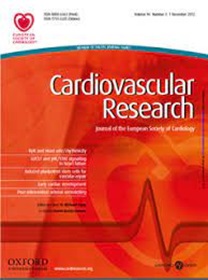绘制人类大脑地形到心脏节律:一项SEEG研究
IF 13.3
1区 医学
Q1 CARDIAC & CARDIOVASCULAR SYSTEMS
引用次数: 0
摘要
几个世纪以来,心脏和大脑之间的相互作用一直是人们感兴趣的主题,因为这种相互作用的功能障碍与各种心血管疾病和神经系统疾病有关。尽管取得了这一进展,但目前对人类大脑与心律沟通的机制了解有限。在这里,我们的目的是表征人脑对心律的处理,并将人脑的地形映射到心律。方法与结果我们研究了54例耐药癫痫患者的大脑如何处理心律,这些患者在术前评估时同时记录了心电图和立体脑电图(SEEG)。颅内心跳诱发电位(HEPs)来源于连续静息状态SEEG时期心跳R峰的平均脑反应,以其形态和在大脑中的时空分布为特征。分析揭示了一个复杂的大脑地形,包括预期的双侧丘脑、脑岛、杏仁核和前扣带皮层,同时也延伸到背外侧前额叶皮层、边缘上回和颞上回。采用本征微态方法,我们在r峰后100至400 ms的时间窗口内解耦了HEPs网络的两个主要组成部分,反映了早期(100-250 ms)和延迟(250-400 ms)的处理路径。此外,我们将人类大脑神经递质受体的特征映射到HEPs的地形上,提供了第一个证据,证明5 -羟色胺受体5HT2a在皮层水平上是该组织的主要特征。此外,通过SEEG进行直接电刺激(DES)后,表现出更强HEPs的大脑区域显示出更明显的心率变化。我们绘制了HEPs在皮层和皮层下区域的时空动态地图。我们对HEPs的表征揭示了各种主要成分,并建立了其地形组织和神经递质受体分布之间的直接联系。这项研究为理解心脏信号的大脑处理提供了一个基础框架,并为新的治疗干预和心血管疾病铺平了道路。本文章由计算机程序翻译,如有差异,请以英文原文为准。
Mapping human brain topography to heart rhythms: an SEEG study
Aims The interplay between the heart and brain has been a subject of interest for centuries, as dysfunction in this interaction is implicated in various cardiovascular diseases and neurological disorders. Despite this advancement, there is currently a limited understanding of the mechanisms that the human brain communicates with heart rhythms. Here, we aim to characterize the human brain processing of heart rhythms and map human brain topography to heart rhythms. Methods and Results We investigated how the human brain processes heart rhythms in a cohort of 54 drug-resistant epilepsy patients who simultaneously recorded electrocardiography and stereoelectroencephalography (SEEG) during pre-surgical evaluation. Intracranial heartbeat-evoked potentials (HEPs) derived from averaging brain responses time-locked to R peaks of heartbeats in consecutive resting-state SEEG epochs, were characterized in terms of their morphology and spatiotemporal distribution across the brain. The analysis revealed a complex brain topography to heart rhythms that includes the anticipated bilateral thalamus, insula, amygdala, and anterior cingulate cortex, while also extending to the dorsolateral prefrontal cortex, supramarginal gyrus, and superior temporal gyrus. Employing an eigen microstates approach, we disentangled two prominent components of the HEPs network in the time window from 100 to 400 ms post R-peak, reflecting early (100-250 ms) and delayed (250-400 ms) processing pathways. Furthermore, we mapped human brain neurotransmitter receptor signatures onto the HEPs topography, providing the first evidence that serotonin receptor 5HT2a serves as a dominant signature of this organization at the cortical level. Additionally, brain regions exhibiting stronger HEPs showed more pronounced heart rate changes following direct electrical stimulation (DES) via SEEG. Conclusions We generated a spatiotemporal dynamic map of HEPs across cortical and subcortical regions. Our characterization of HEPs revealed various dominant components and established a direct association between its topographic organization and distribution of neurotransmitter receptors. This study provides a foundational framework for understanding the brain processing of heart signals and paves the way for novel therapeutic interventions and cardiovascular diseases.
求助全文
通过发布文献求助,成功后即可免费获取论文全文。
去求助
来源期刊

Cardiovascular Research
医学-心血管系统
CiteScore
21.50
自引率
3.70%
发文量
547
审稿时长
1 months
期刊介绍:
Cardiovascular Research
Journal Overview:
International journal of the European Society of Cardiology
Focuses on basic and translational research in cardiology and cardiovascular biology
Aims to enhance insight into cardiovascular disease mechanisms and innovation prospects
Submission Criteria:
Welcomes papers covering molecular, sub-cellular, cellular, organ, and organism levels
Accepts clinical proof-of-concept and translational studies
Manuscripts expected to provide significant contribution to cardiovascular biology and diseases
 求助内容:
求助内容: 应助结果提醒方式:
应助结果提醒方式:


